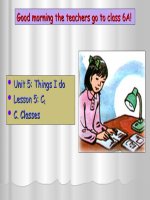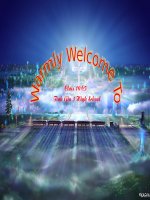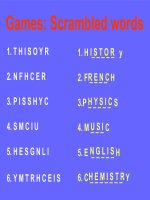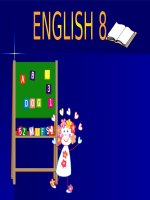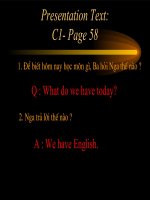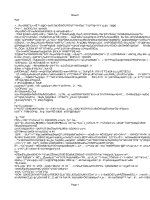Unit 5 (Lifeline Elementary)
Bạn đang xem bản rút gọn của tài liệu. Xem và tải ngay bản đầy đủ của tài liệu tại đây (2.02 MB, 28 trang )
Unit 5 likes and
dislikes
1. Read and listen to the conversations.
New words: - like /laik/
- dislike / dislaik/
- ticket /’tikit/
- restaurant /'restr ntɔ /
- skiing /'ski:iη/
- Chinese food /'t∫ai'ni:z fu:d/
2. Match the conversation and the pictures.
1-b 2-d 3-a
4-c
RULES
1. The verbs in the conversation are in the
present tense.
eg: I like Chinese food.
I prefer snowboarding.
a. Complete this sentence from conversation 2
I tea.
b. How do we make the negative form?
c. How do we make questions? Write an example
here?
don’t like
Do you like Shakespear?
2. Find another example of
-
a positive statement
-
a negative statement
-
a question
I like Chinese food.
I don’t like Chinese food.
Do you like Chinese food?
3. Complete the short answers.
•
A. Do you like this restaurant?
B. Yes,_____ .
2. A. Do you like rugby?
B. No, _____ .
* Check the rules for the present simple
tense
I do
I don’t
The present simple tense
Form: (+) S+ V(s,es).
(-) S+ do/does + not +V.
(?) Do/ does + S+ V?
Use:
- Regular events or permanent states.
eg. He often gets up at 6:00 everyday
-
General truths
eg. The Sun rises in the east.
Language focus: Like + - ing
a. Which sentence is correct?
I like ski.
I like skiing.
b. Check your answer in conversation 3.
c. Look at these verbs. How do we make ing – forms
play playing
drink drinking
run running
drive driving
The rules for like + -ing
When we use a verb after like, we usually use the -ing
form of the verb.
eg. I like swimming.
Do you like driving?
She likes reading books.
He doesn’t like watching TV.
Practices
1. Look at these things. Which ones do you like?
swimming cats
golf
operashopping
cooking
tennis
driving
learning English pop music
dogs
dancing
a. Write your ieads.
eg. I like swimming, but I don’t like
cats
b. Ask and answer with the partner.
eg. A. Do you like swimming?
B. Yes, I do/ No, I don’t./ They
are all right, but I prefer
2. Look at these sentences.
a. Complete the sentences with I or I don’t and
the verbs in the box.
1. ______tea in the morning.
2. ___________three languages.
3. ________the piano.
4. ________radio to TV.
5. _________men with beards.
6. ________to school.
7. __________from Japan.
8. __________a red car.
speak play go drive like prefer drink come
I don’t speak
I play
I drink
I don’tcome
I prefer
I go
I don’t drive
I don’t like
b. Ask and answer with the partner.
eg. A: Do you drink tea in the morning?
B: Yes, I do./ No, I don’t.
3. Write sentences with your own ideas. Use
I(don’t) and the verbs in the box.
like play drink speak
ride buy watch prefer
come read write cook
have to smoke
eg. I don't have to learn at weekends.
1. Look at the spider diagram
a. Write the name by the pictures. Use a
dictionary to help you
Food
Drinks
Vegetables
Other
Meat
Fruit
b. Listen and check your ideas
c. Can you add any more words?
carrots (n)
biscuits (n)
watermelon (n)
ice-cream (n)
gabbage (n)
2. Work with a partner.
Ask what she/ he likes.
Work in pairs. Complete the small
dialogue
A: Do you like______?
B: Yes, I__. Do you _____milk?
A: No, __don’t.
B: Do you like____________?
A: Yes, I do.
coffee
drink do
I
cream cakes
Reading and writing what you eat?
1. Ask your partner.
1. When do you have breakfast/ lunch/ dinner?
I have breakfast at 7:30 a.m.
2. Which is your big meal of the day?
My big meal of the day is lunch.
3. What do you have for breakfast/ lunch/
dinner?
I have meat, rice and vegetables for lunch.
4. What do you drink with your meals?
I drink water with my meals.
5. Do you go to the restaurants or pubs?
New words
toast (n ) / toust/
salad (n ) / 'sæləd/
pasta (n ) / 'pæstə/
dessert (n ) / di'zə:t /
custard (n ) / 'k stədʌ /
apple pie (n ) / 'æpl pai/
a pint of beer (n ) / paint əv biə/
2. Read the text and complete the charts
Meals When? What?
1. Breakfast
2._______
3._______
Meals When? What?
1.________
2.________
3.________
Roy and Joan
Betty and Phil
5: 30 a. m
1: 30 p. m
7: 30 p. m
12: 00 p. m
5: 00 p. m
toast, coffee, orange-juice
7: 30 a. m
a salad or soup, a sandwich
meat/ fish, vegetables,
potatoes, pasta/rice
bacon, sausages and eggs, tomatoes,
mushroom, toast; tea
meat, potatoes, vegetables, pudding
( apple pie, custard)
eggs/cheese on toast, cakes,
biscuits; tea
Language focus: Countable
and uncountable nouns
a. What is the difference between two pairs of
sentences?
This is an apple. I like apples.
This is cheese. I like cheese.
b. Some nouns in English haven’t got a plural
form. We call these uncountable nouns. Look
at the words in a. Which is uncountable?
c. Read the conversations. When do we use how
much and how many?
A: I need some eggs.
B: How many do you want?
A: I need some rice.
B: how much do you want?
d. Work with a partner. Use the conversation in c.
Ask and answer about the food and drinks on
this page.
Check the rules for countable and
uncountable nouns in Grammar
reference 5. 3
3. Read the texts again. Which couple
is it?
1. They drink coffee in the morning.
2. They have breakfast at half past five.
3. Lunch is their big meal of the day.
4. They eat ice-cream for dessert.
5. They drink tea with their meals.
6. They don’t eat fish.
7. Lunch is a light meal.
8. They go to the pubs at the weekend.
9. They like Italian food.
B & P
B & P
B & P
B & P
R & J
R & J
R & J
R & J
R & J
4. Compare the information in the charts
with their own meals. What differences
are there?
eg. I have breakfast at 6:15.
I often have bread and cheese.
I drink milk in the morning.
Our big meal of the day is lunch.
5. Write about your meals
On weekdays I have breakfast at ___. I
usually have ____________. For lunch I
have____________________. That’s
at____________. I have dinner at___________.
I usually have______________. At the
weekends______________________________.
I like__________.
6:30
bread and milk
meat, rice and vegetables
half past eleven seven o’clock
fish, soup and rice
I always have a big meal with my family
Chinese food
Language focus: some and any
a. Look at the conversation.
A: Have you got any cheese?
B: No, I haven’t got any cheese, we’ve got some
ham.
b. Complete the rules with some and any.
We use_____ in positive statements.
We use____ in negative statements and questions.
some
any
c. Look at the spider diagram. What things
have you got in your fridge at home?
Example
We’ve got some bear. We haven’t got any
wine
d. Ask your partner about his/ her fridge
Example
A: Have you got any beer?
B: Yes, we have / No, we haven’t.
Check the rules for some and any in
Grammar Reference 5.4
